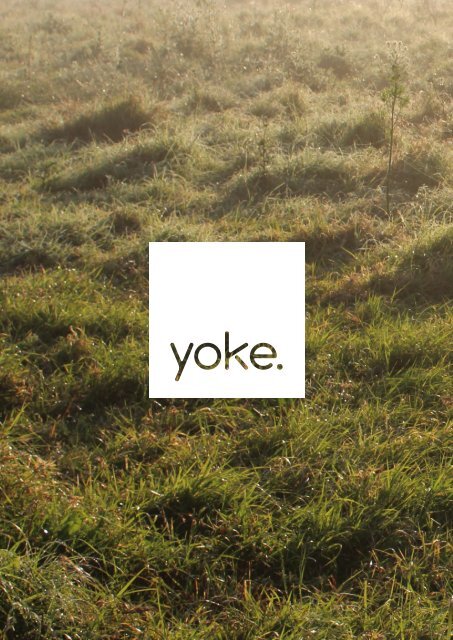Yoke Magazine
Create successful ePaper yourself
Turn your PDF publications into a flip-book with our unique Google optimized e-Paper software.
OKE<br />
NTRODUCTION
1Say hello to YOKE!<br />
YOKE is a collection of networked furniture pieces that mark the future of<br />
interactive furniture design and passive technologies, in the context of the<br />
contemporary home. Integrated with an accessible, dynamic, digital platform,<br />
YOKE works to develop a holistic collection of products that enhance daily microrituals,<br />
facilitate habituated actions and meet the needs of the emerging technocentric<br />
demographic. The collection works to translate digital experiences into<br />
analogue intuitive gestural interactions, working to enrich the users interaction<br />
with technology in the context of the home.<br />
YOKE’s branding image works to develop a holistic identity; tying together the<br />
digital and interface design, with a contemporary furniture and homewares<br />
aesthetic. Maintaining a constant brand image works to develop a connected,<br />
integrated product ecosystem while providing a platform for further development<br />
and diversification of products and services. YOKE’s minimalist, contemporary<br />
branding aims to appeal to the broad range of values and interests of the<br />
intended target demographic, while enabling the product range to appeal to a<br />
broad audience and a range of contemporary applications.
ERVICE
2More than just technology integrated into furniture, YOKE works to develop a networked<br />
service focused on security, social connectivity and self-reliance. To enhance the<br />
connectivity between products, the YOKE system makes use of the contextualised<br />
network of the home, though the use of the home WIFI network; transforming the<br />
product family from a series of separate furniture pieces to a interconnected and<br />
dynamic product ecosystem. The products’ communicate, gather information and<br />
connect to services and social networks using the home network, further enhanced<br />
though our application interface design. By linking the collection through our digital<br />
platform, the individual products transition to a full customisable ecosystem, which<br />
can be tailored to meet the needs of the individual user.<br />
YOKE’s position in the progression of service design is highlighted though its<br />
ability to meet the three driving service based movements; digital democratisation,<br />
dematerialisation and disintermediation. Throughout its product lifecycle the system<br />
works to aid in the democratisation of interactive technologies by facilitating the<br />
collection of information surrounding user’s interactions, habits and lifestyle to improve<br />
performance, enhance use and customise interactions. The system contributes to the<br />
dematerialisation of technology, by seamlessly integrating technology into furniture in<br />
context the home and reducing the need for screen based interfaces during use.<br />
As a result of the connectivity embodied throughout the YOKE collection, user habits,<br />
trends and information can be gathered between the products, interpreted, and<br />
leveraged to provide valuable services to the user group. Though its daily use, YOKE<br />
can use the sensors embed into the pieces to gather information about the users<br />
habits within the home to provide a subtle, smart security system. The furniture works<br />
as both the input, gathering data and interpreting patterns, and the output, providing<br />
deterrents and contacting services, to develop a holistic, subtle home security system,<br />
without the need to ever touch a key pad or turn a deadbolt. Lastly, the YOKE product<br />
range works to promote digital disintermediation by providing an avenue to connect<br />
users to social mediums, services and individuals through the use of networked<br />
technologies and IoT protocols.<br />
At a social level, the YOKE ecosystem works to promote positive social interaction,<br />
community engagement and enhance self-reliance. By interpreting the habits and<br />
routines of the user, the ecosystem can work to connect users to family members,<br />
friends and community events, through subtle notifications and application interfaces.<br />
Furthermore, the system works to help the user optimise their digital lifestyle by helping<br />
them to reduce interaction with screen based interfaces and traditional interaction<br />
methods.<br />
By developing a holistic digital platform, a dynamic product range and customisable<br />
interactions, the YOKE system is positioned to meet the needs of a large emerging<br />
demographic, and be adapted to suit a wide range of user values and needs.
3Two emerging trends in Australia’s future involve the<br />
emerging population of the ‘new old age’; an increasing<br />
ageing population of technology literate users, while<br />
urbanisation and urban population density increases.<br />
Backed by statistics from the Australian Bureau of<br />
Statistics, nearly 80% of 65-74 year olds live in a<br />
private dwelling with a spouse or partner, while one<br />
quarter of older people lived in a private dwelling<br />
alone, representing a total population of 719 300 older<br />
individuals living alone (abs.gov).<br />
Together these demographic and socio-cultural trends<br />
hint at an emerging market for products focused on<br />
the home, which provide valuable functions to facilitate<br />
self-reliance and social engagement. Technological<br />
literacy, personal health, community engagement and<br />
social interaction are fast becoming prominent issues to<br />
be addressed in Australia’s ageing future, and provide<br />
an interesting avenue for design intervention and<br />
opportunity.<br />
YOKE works to meet this emerging market segment<br />
by providing an opportunity for users to engage with<br />
digital platforms though familiar gestural interactions,<br />
enhancing self-reliance through consideration and<br />
design of feedback and attention notifications,<br />
connecting users to social platforms and services and<br />
more importantly; designing engaging, intuitive products<br />
that appeal to the user and promote use.
USER GROUP<br />
25%<br />
of Australias<br />
population by<br />
2055 will be 65+<br />
80%of 65 - 75 year<br />
olds live in a<br />
private dwelling<br />
with over<br />
719k<br />
of these living alone
DESIGN<br />
DESCRIPTION
4Through research, design development, concept<br />
iteration, software and electronic development, model<br />
making and testing; the YOKE collection has been<br />
designed to meet the needs of the user audience<br />
and deliver an intuitive, refined, product solution. The<br />
collection is comprised of three unique products that<br />
integrate and communicate through an application<br />
interface. The collection includes KEEP; an interactive<br />
key bowl, LUME; a two part smart lighting product<br />
family, and REST; a bed side table that makes use of<br />
gestural interactions to control audio and lighting.<br />
To enable customisation and control of the interactions,<br />
gestures and connectivity of the three products, an<br />
application interface was designed. The YOKE app<br />
allows users to personalise their experience with<br />
the product ecosystem, customise interactions, and<br />
connect to social platforms. The interface is designed<br />
to be easy to use, with a dashboard for quick access to<br />
most used controls, and a simple menu interface. The<br />
primary function of the application is to act as point of<br />
control for the products higher level functions, allowing<br />
the user to interact and engage with the ecosystem<br />
in a detailed view and with a more advanced level of<br />
control. Furthermore, the app also serves as the users<br />
interaction with system settings, warranties and product<br />
information.
ESIGN VALUE<br />
ROPOSITION<br />
5<br />
The YOKE product range adds value to users by enhancing daily rituals, enriching<br />
community and social engagement, improving home security and advancing<br />
interaction with technology within the context of the home.<br />
The product ecosystem works to enhance the users daily micro rituals, through<br />
strategically positioned, and designed, interactive pieces. Each component in the<br />
product family works to engage the user through input sensors and visual and audible<br />
feedback. Working together, these pieces aim to improve self-reliance and enable<br />
positive habit formation. Visual feedback and subtle attention profiles are designed<br />
to promote product interaction and use over time, working to enhance existing rituals<br />
and facilitate new habituated ritual practises.<br />
The YOKE system works to enrich and enable community engagement and social<br />
interaction by making use of the products connected features and IoT communication.<br />
Throughout the products use, the system passively connects users to social media<br />
platforms, and tailors notifications based on product interaction and formed habits.<br />
Connectivity derived from data gathered from the users action and habits can be used<br />
by the platform to suggest activities, prompt social interaction between users and<br />
contribute to the social security features of the network.<br />
Using the sensors and connectivity designed into the product ecosystem, the YOKE<br />
network forms an interactive, dynamic security system, with a focus on social<br />
connectivity and subtle control. Infrared sensors embedded in the LUME lights and<br />
KEEP bowl provide a holistic movement sensing network, providing an avenue for<br />
lighting profiles, audio deterrents and interface notifications to occur if motion is<br />
detected throughout the home. Using this data collection, the <strong>Yoke</strong> social security<br />
system can notify family members, friends or emergency services to take action. Using<br />
these integrated technical features, and an overarching application control scheme,<br />
the YOKE system transitions home security from a complex, subscription service, to a<br />
streamlined, subtle network of embedded smart sensors and screen less interactions.<br />
The social security system makes use of the home’s wireless network to enable<br />
communication between sensors, as well as serving as the access ‘key’ for the<br />
primary user to differentiate between the resident and other individuals. Furthermore,<br />
the wireless network access enables the primary user to share home access with<br />
anyone with the network code.<br />
Lastly, YOKE’s holistic approach to gesture based interactions works to advance<br />
the role of connected IoT technologies in the home and address issues relating to<br />
technical literacy in the new old age. The YOKE system relies on passive gestural<br />
controls, enabling users to interact with the product range without the need for a<br />
screen, physical interface or complex analog interaction. Together, these attributes<br />
work to develop an inclusive, intuitive control interface that promotes ease of use and<br />
longevity in the product lifecycle.
ENHANCING<br />
DAILY RITUALS,<br />
ENRICHING<br />
COMMUNITY<br />
AND SOCIAL<br />
ENGAGEMENT,<br />
IMPROVING<br />
HOME SECURITY<br />
AND ADVANCING<br />
INTERACTION<br />
WITH<br />
TECHNOLOGY<br />
WITHIN THE<br />
CONTEXT OF THE<br />
HOME
EEP
The design justification of the KEEP bowl centres around the products aesthetics,<br />
functional form, interactive elements and product usability. The bowl structure<br />
is designed to accommodate a wide range of uses, with considered space for<br />
an array of objects users may engage with throughout the products lifecycle.<br />
The bowl itself is formed using slip cast ceramic casting, allowing a high level<br />
of internal detail to be resolved, while accommodating the internal electrical<br />
components and ensuring a durable structure. To contrast with the texture<br />
and aesthetics of the bowl, the shelf housing is manufactured from end grain<br />
plywood profiles, matching the consistent aesthetic of the YOKE product range<br />
as a whole. The internal edges of the shelf are lined with wool felt to improve<br />
component fitting and add aesthetic detailing. Felt detailing inside the bowls<br />
surface is also used to enhance function by providing a soft surface to place<br />
objects on inside the bowl. Under this felt surface, a light sensor works to detect<br />
objects in the bowl, adding to the functionality and feedback designed into the<br />
products function.<br />
The interactive elements designed into the keep bowl focus on subtle interaction<br />
and passive visual feedback, in the form of internal LED lighting. RFID interaction<br />
is designed to accommodate use in a variety of products, and through considered<br />
component placement, enables reading on internal and external faces.<br />
The contextualisation of the KEEP bowl is centred around its placement and<br />
position within the architectural layout of the home, and plays on the semantics<br />
of the first point of contact of furniture at the front door of the home. As a result<br />
of this positioning, enhanced by the auxiliary shelf housing, the KEEP bowl<br />
serves as the first point of contact in the YOKE series and begins the interactive<br />
sequence.
EST<br />
The REST bedside table is designed to suit the context of the contemporary<br />
bedroom, with a friendly, approachable form, and a low profile form factor. The<br />
height of the table is ergonomically suited to the height of a bed surface, while the<br />
internal storage space provides room for books, blankets and general storage.<br />
The materials selected for the REST bedside table are designed to reflect the<br />
aesthetic style of the collection, and enhance visual interest and function. The<br />
body of the table is manufactured from laminated plywood cross sections<br />
mounted onto white powder-coated steel plates, with welded opposing angled<br />
steel legs, which provide a stable and aesthetically dynamic profile.<br />
The body of the table acts as the interface surface, drawing connections to<br />
gestural interfaces and physical interaction elements. As the user runs their<br />
hand across the wooden top surface, the capacitive touch contacts built into the<br />
surface provide a subtle feedback through LED’s embedded under the surface of<br />
the timber. Together these technical components work to enhance functionality<br />
and provide passive gestural control over the product, without detracting from<br />
the minimalist aesthetic of the products form.<br />
The interface sequence and mapping is designed to translate digital screen based<br />
interactions into gestural actions, while giving clear visual feedback to clarify<br />
these actions. Semantically, the interaction suits the preconceived mapping of<br />
digital controls in a new context.<br />
Lastly, the REST table contains a capacitive charge surface embedded into the<br />
body. This component enables users to charge electronic devices by placing<br />
them on the surface of the table. By using the application interface in conjunction<br />
with the charging surface, the user can enable a ‘do not disturb mode’ designed<br />
into the application interface. Push notifications from the phone will be silenced,<br />
and a subtle, unobtrusive indicator LED activates on the tables surface. This<br />
feature enables users to disconnect from technology, and instead provides an<br />
output for subtle, silent notifications.
UME
The LUME light product family is designed to tie together the components within<br />
the YOKE collection. The light and audio system acts as the primary output for<br />
the furniture pieces, as well as making use of its own self-contained internal<br />
sensors and outputs. The LUME lights use infrared sensing technology to sense<br />
movement, both direct and ambient. Direct motion sensing is used to translate<br />
gestural controls into light outputs; by swiping a hand under the pendent light the<br />
user can adjust light intensity as required. Through ambient motion sensing, the<br />
LUME family acts as a holistic network of motion sensing products, contributing<br />
to the social security ecosystem of the YOKE collection by enabling light and<br />
audio deterrents, and custom profiles, for events and actions.<br />
The LUME product family is separated into two product variants, defined by<br />
their individual context of use. The LUME bar light serves as a central lighting<br />
element to provide light to the home entrance and large living areas, while the<br />
LUME pendent provides more direct light to suit the bedroom environment. Both<br />
lighting products also contain bluetooth enabled speakers, contributing to the<br />
product family connectivity with home media and streaming technologies.
ENJOY @Y.OKE






